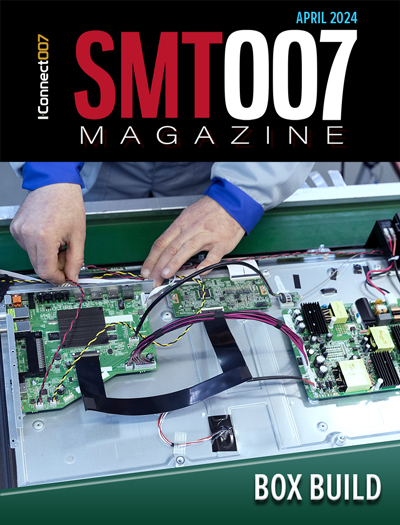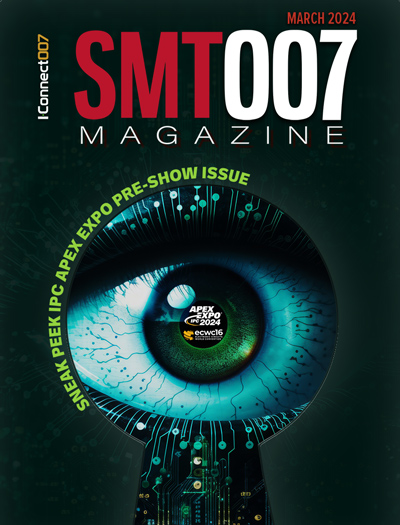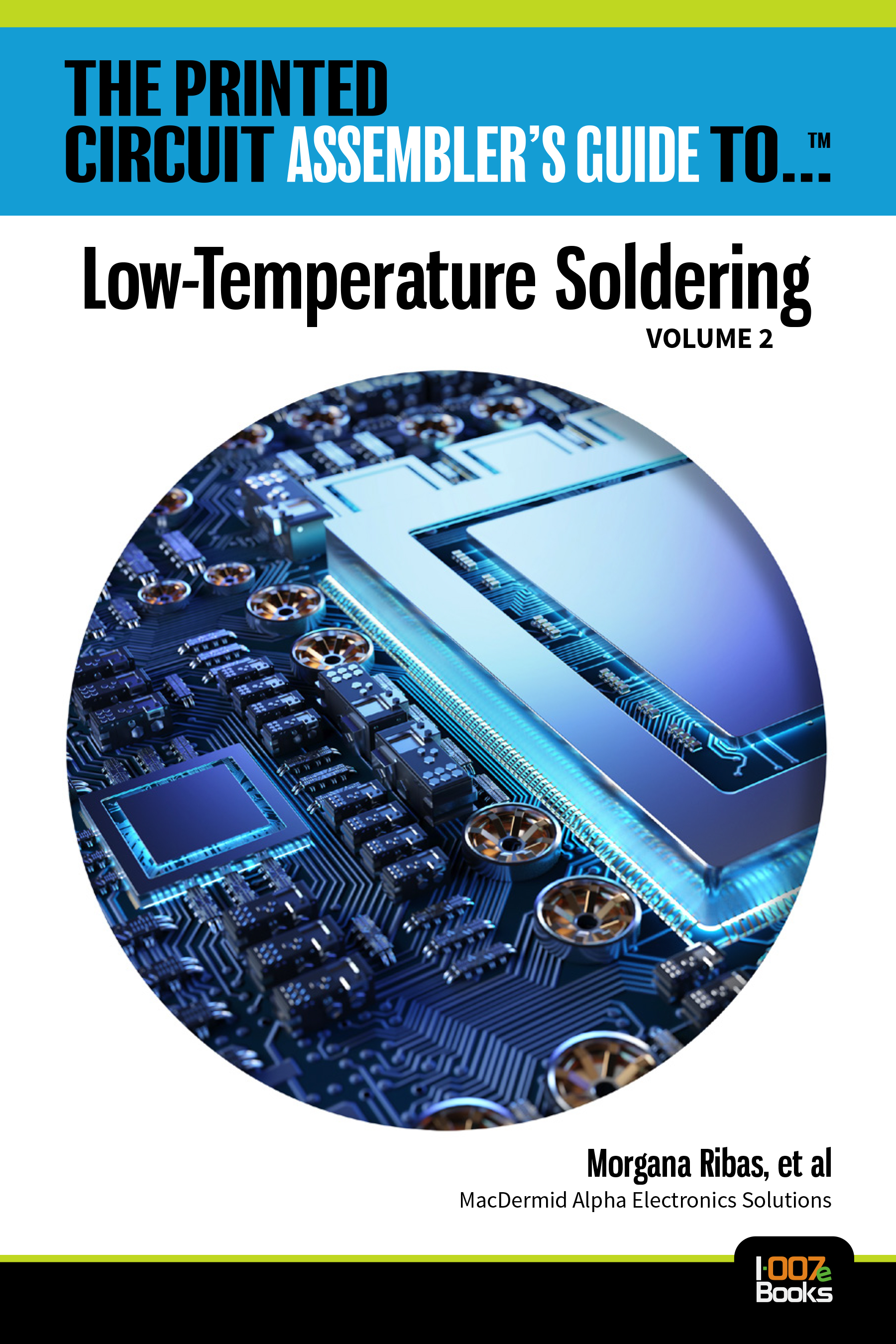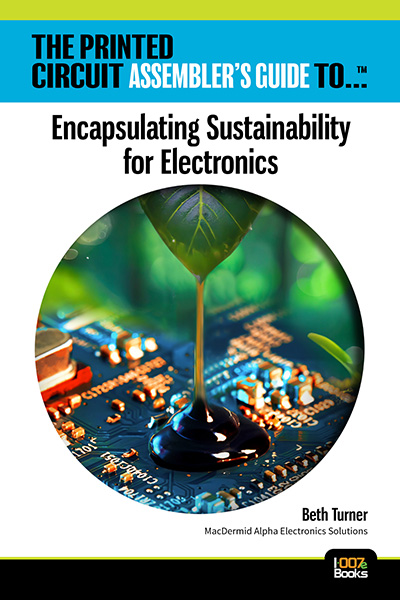-

- News
- Books
Featured Books
- smt007 Magazine
Latest Issues
Current Issue
Box Build
One trend is to add box build and final assembly to your product offering. In this issue, we explore the opportunities and risks of adding system assembly to your service portfolio.

IPC APEX EXPO 2024 Pre-show
This month’s issue devotes its pages to a comprehensive preview of the IPC APEX EXPO 2024 event. Whether your role is technical or business, if you're new-to-the-industry or seasoned veteran, you'll find value throughout this program.

Boost Your Sales
Every part of your business can be evaluated as a process, including your sales funnel. Optimizing your selling process requires a coordinated effort between marketing and sales. In this issue, industry experts in marketing and sales offer their best advice on how to boost your sales efforts.
- Articles
- Columns
Search Console
- Links
- Events
||| MENU - smt007 Magazine
Latest Articles
What Does an OEM Really Gain from Outsourcing their Manufacturing?
But what does an OEM really gain when they make the move from an in-house manufacturing operation to an outsourced one? This article looks at two key benefits OEMs stand to gain once they relinquish control and hand over their production responsibility to an EMS provider.
Creating the Perfect Solder Joint
From a visual standpoint, a good solder joint should be smooth, bright, shiny, clean, and have a nice concave solder fillet. But how do you ensure that inside those joints, good intermetallic bonds are formed? Solder joints play several different roles, and they represent several different opportunities to be a problem, a partial improvement, or a complete improvement. Since all solder joints aren’t created equal, the first step is to understand what is expected or required of that joint.
Cleaning Trends: The Challenges of Miniaturization and Proximity
At the recent SMTA International conference, I-Connect007 Managing Editor Patty Goldman caught up with Ram Wissel, VP of Global Technology at KYZEN, to talk about the latest cleaning challenges, and bringing Industry 4.0 into the world of cleaning in PCB assembly.
Soldering Tip: Key to Good Solder Joints
In an interview with SMT Magazine, Enrique Moreno, technical support engineer at JBC Soldering, discusses the key parameters to consider during hand soldering to achieve the perfect solder joint. He also talks about the the increasing move towards automation and robotics soldering.
Achieving the Perfect Solder Joint: The Many Perspectives on Soldering
For this month's issue of SMT Magazine, we brought several experts together to discuss the many aspects of soldering, from solder paste, to automation, inspection, and the challenges in achieving the perfect solder joint. We also talked about the strategies and parameters to consider to ensure reliable, good solder joints.
Surprising European EMS Market Numbers
If you think market analysis is always correct and predict the future exactly, you are mistaken. The latest annual reports from EMS companies with manufacturing sites in Europe have changed the picture on the European EMS industry quite a bit and caught us by surprise. Yes, you read that correctly: SURPRISE.
Should I Involve My EMS Partner in DFM?
OEMs are seeking the support of EMS providers with more than just manufacturing, but with design elements too. One of the main design services EMS providers will be likely to offer is design for manufacture (DFM). This article highlights why engaging your EMS partner in DFM is worthwhile, and will be valuable in securing the longevity of your product.
Choosing Solder Processes: Getting It Right
In an interview with SMT Magazine, Ralf Wagenfuehr, plant manager at Rehm Thermal Systems, shares his insights on the topic of achieving the perfect solder joint, from the perspective of a reflow oven supplier. He also talks about the latest developments in reflow ovens aimed at addressing voiding in solder joints.
Moving Toward the Zero-Defect Line
During the recent NEPCON South China exhibition in Shenzhen, Olivier Pirou, chief operating officer of Vi TECHNOLOGY, talks about achieving the perfect solder joint from the point of view of an inspection systems provider, and how manufacturers can strategize to achieve a zero-defect line.
Spreading the Word about SMTA—One Local Show at a Time
Eileen Hibbler of TEK Products, who currently sits on the Board of Directors of SMTA and is the VP of Membership, talks about educating the people in the industry; the importance of the local shows; SMTA's university chapters and their initiatives; and how SMTA is reaching out to millennials.
Test Solutions Your EMS Partner Should Offer
When looking to outsource your manufacturing, you need to know that your chosen EMS partner has good test solutions in place so that they can produce consistent, high-quality products to your customers’ requirements. This article highlights the importance of test, and outlines the different types of test your EMS partner should offer.
Joining Forces: SMTA and the SMART Group in Europe
Tanya Martin, executive director at SMTA, and Keith Bryant, global director of sales for YXLON International and chairman of the SMART Group, speak with I-Connect007 Managing Editor Patty Goldman about the latest initiatives within their associations, and discuss some interesting news about an upcoming merger.
A Guide to IPC Survey and Report Season
IPC Director of Market Research Sharon Starr found time to discuss the recently conducted and published surveys and research reports and a few others still in the works. These reports are free to survey participants, which is certainly a great incentive for taking the time to complete them. (Hint: That’s a call to action for those of you sitting on the sidelines.)
Counterfeit: A Quality Conundrum
The rise in the ingress of counterfeit materials into the supply chain has made them prolific, though yet, the extent is understated. What needs to be faced now is the need for incoming inspection, but at what cost to industry, and does anyone remember how to do it?
Rework and Reball Challenges for Wafer Level Packages
Amid the growing trend in package and PCB miniaturization, wafer-level packages (WLPs) have garnered recent popularity for their affordable cost, small footprint, and thin profile. Component suppliers must be prepared to support failure analysis for PCB-assembled WLPs, including fault isolation, nondestructive screening, as well as destructive analysis techniques.
Eight Factors a CEM Should Know About its Suppliers
Selecting a contract electronics manufacturer (CEM) that fits well with your outsourcing strategy can be a difficult and long process. But, by taking the time to research and investigate potential shortlisted partners, you are much more likely to reap the benefits further down the line.
Three Reasons to Use PCB Panel Routing Techniques
Most PCBs are individually routed—meaning they're not panelized. That doesn't mean that, sometimes, sending them to a PCB assembler in a panel isn't a good idea or even required. Generally, assemblers don't require panels, but there are some cases when they do.
IPC Status Update: Training, Standards, and More!
At the recent IPC Fall committee meetings that are co-located with the SMTA International conference and show, IPC’s president and CEO, John Mitchell, sat down for a chat with me for an update on what’s happening at IPC.
RTW SMTAI: Mentor Eases Programming in Viscom Inspection Systems
Jesper Lykke, engineering manager for USA of Viscom AG, and Zac Elliott, technical marketing engineer at Mentor, speak with I-Connect007 Managing Editor Andy Shaughnessy about Viscom's adoption of the Valor Process Preparation and how it is helping users with their inspection programming.
Top Five BGA Challenges to Overcome
Higher reflow temperatures of lead-free rework increases the pressure for properly shielding the neighboring components. These developments are causing BGA rework challenges. This summary will discuss the most challenging aspects of BGA rework and options for solutions.
RTW SMTAI: EPTAC Discusses Manufacturing Training Trends
During SMTAI International 2017, Leo Lambert, vice president and technical director of EPTAC, discusses with I-Connect007 Managing Editor Andy Shaughnessy his company's recent expansion and the trends he's seeing in manufacturing training.
Update on IPC’s Validation Services and Hints of What’s to Come
SMTA International is the perfect time to get updates on IPC happenings. One that I’m always curious about is the Validation Services programs. At the busy show, I managed to find a quiet spot so Randy Cherry, IPC’s director of Validation Services, could fill me in on the latest.
BTC and SMT Rework Challenges
In the assembly of bottom terminated components (BTC), the formation of voids has become a serious problem in many applications. In the SMT process, the reliability of solder joints becomes more of a concern, as less and less solder is allowed for each joint. The presence of voids can deteriorate the joint strength and eventually lead to joint failure.
RTW SMTAI: How Automation and Government Support Can Help Reshoring Drive
Alex Malek, vice president of sales and service for North America of SAKI, speaks with I-Connect007 Managing Editor Andy Shaughnessy about how automation and government investment can help bring back manufacturing jobs from overseas.
RTW SMTAI: AIM's Dr. Mehran Maalekian Speaks on New Alloys for Harsh Environments
Dr. Mehran Maalekian, R&D Manager at AIM Solder, speaks with I-Connect007 Managing Editor Andy Shaughnessy about new alloys that are targeted for high-temperature and demanding applications, particularly in harsh environments, where standard lead-free alloy such as SAC will not perform as well.
Is Hybrid Technology Gaining Momentum?
Over the past 20 years, ceramic hybrids have changed more and more to a backyard living in the European electronics industry, mainly driven by price pressure, specifically from the automotive electronics industry.
IPC’s David Bergman on Industry Training and Education
David Bergman, vice president of standards and technology at IPC, talks about the biggest issues facing the electronics manufacturing industry now. He also explains how the organization helps elevate the industry through its training, continuous education, and standards development.
How to Prevent Suspect Components from Entering Your Supply Chain
The success of any supply chain relies on quality and stability. If either of these elements are threatened, OEMs or their EMS provider will struggle to ensure supply chain excellence. Unfortunately, with the risk of counterfeit and other suspect components ever present, this can sometimes be difficult to achieve.
Institute of Circuit Technology Hayling Island Seminar 2017
This year’s event had a well-chosen and varied programme featuring presentations on process chemistry and R&D consortia, a discussion of controversial standards proposals and a review of the experiences of commissioning new technology in a start-up factory.
The Root Causes & Solutions for Warped PC Boards
There are two primary types of causes of board warping: process related at the fab or assembly shop, and layout related issues. If it's warped before assembly, it's between fab and layout. If it's flat before assembly and warped after, it's most likely between layout and assembly. That said, sometimes a fab problem won't show up until a pass through the reflow oven at your assembly partner.
RTW SMTAI: Alpha Discusses Solder Dross Reclamation
At the recent SMTA International 2017 exhibition in Rosemont, Illinois, Mitch Holtzer, director of Americas Reclaim Business of Alpha Assembly Solutions, talks with Managing Editor Andy Shaughnessy about the solder dross reclamation process, and discusses his new role in leading Alpha’s reclamation business.
Implementing a Capacity Planning Tool
One of the more common challenges we see in the EMS world is that through the outsourcing of their manufacturing, many OEMs have forgotten the fundamentals of supply chain management and expect quick turnaround on orders without taking into consideration the whole supply chain constraints or the impact of not providing accurate forecasts to the EMS partner.
RTW SMTAI: MIRTEC on Staying Ahead of the Curve
Brian D’Amico, president of MIRTEC, talks with I-Connect007 Managing Editor Andy Shaughnessy about some of the latest 3D AOI challenges, including dealing with highly reflective surfaces of solder joints or wafer-level die, which make it impossible to characterize in 3D. He says it's not just plain SMT boards anymore, but an integration of wafer-level manufacturing, which they see as coming down more and more.
RTW SMTAI: Gary Tanel Discusses How SMTA Helps the Industry Evolve
At the SMTA International 2017 exhibition in Rosemont, Illinois, Gary Tanel, president of the SMTA Dallas Chapter, speaks with I-Connect007 Publisher Barry Matties on a myriad of topics, including the goal of the SMTA as an industry association, and how it is helping the industry evolve. They also discussed challenges and strategies in bringing more young people to the industry.
Sensible Design: Thermal Management—The Heat is On
Thermal management materials are designed to prolong equipment life and reduce incidences of failure. They also maintain equipment performance parameters and reduce energy consumption by reducing operating temperatures, and minimising the risk of damage to surrounding components. Indirectly, they maintain brand reputation, as the reliability of the equipment will be very dependent upon the effectiveness of the thermal management technique used.
Drying Boards after Rework Cleaning—To Do or Not to Do?
In cases where water soluble fluxes are being used in the rework process, in cases where the components need to have flux residues washed off, or in cases where the board needs to be cleaned with water for subsequent conformal coating touchup, proper drying and perhaps even bake out procedures need to be performed.
What's Up in Scandinavia's EMS Industry?
Scandinavia, consisting of Denmark, Norway, Sweden, and Finland, is relatively small in regards to the overall European EMS revenues, and counts for less than 6% of the European EMS production value. Nevertheless, more than 160 companies offer EMS services, not to mention companies who only manufacture cable harnesses or just do design work, box building, and after-sales services.
Rework and Reliability: Less is More!
Circuit boards are not always perfect after reflow or wave soldering. Scrapping boards with one or two defects is expensive, so rework happens. A good concept for rework is less is more, especially less flux. Use as little rework flux as possible, as in the old Brylcreem ads, "Just a little dab'll do ya."
Does My Outsourcing Project Fit with the EMS Provider's Strategy?
Once a decision has been made to outsource your electronics manufacturing, the next step is to find a suitable partner. This article highlights some of the questions, checks and balances a good EMS company will carry out before deciding to quote or partner with an OEM. Hopefully, by providing this insight, you will be better placed to find the right supplier for your outsourcing project.
RTW NEPCON South China: Rehm on Machine Communications and Vacuum Technology in Reflow
Ralf Wagenfuehr of Rehm Thermal Systems speaks about the need for a common communications platform as the industry moves toward Industry 4.0. He also talks about how their new ViCON software can help manufacturers achieve the smart factory vision.
RTW NEPCON South China: Vermes Discusses Piezo Technology in Microdispensing
During the recent NEPCON South China event in Shenzhen, Juergen Staedtler, CEO of Vermes Microdispensing GmbH, discusses their latest innovations in microdispensing, and how their piezo technology is addressing the trend towards miniaturization in PCB assemblies.
A Look Into PCBA Rework and Repair
Despite the many technology advances in the SMT process, there will always be a need for rework and repair of PCB assemblies. Most especially as the industry trend continues towards finer pitch and spacing, smaller and smaller components, and increasing high-reliability requirements from customers.
RTW NEPCON South China: JBC Brings Digital Transformation to Hand Soldering Process
Enrique Moreno, technical support engineer at JBC Soldering SL, and I-Connect007 Managing Editor Stephen Las Marias discuss the latest developments in the hand soldering process, including robotics and automation. Moreno also talks about the opportunities in China, and why their Industry 4.0-enabled solutions are suitable for this market.
Should You Entrust Your EMS Provider With Your Supply Chain?
Managing your supply chain can be time consuming and expensive and, more importantly, it can distract you away from other key activities such as sales, marketing and product design. As an OEM, however, it's unlikely that your supply chain is a 'core' activity, that is, something that adds real value to your customers. So, what are your options?
Whose Fault is That Bad Board?
Years ago, I held a position in an EMS company where projects were analysed before manufacturing. We found that even some of the best and most innovative circuits could not be manufactured. Why? Because the PCB designer, an electronic engineer, was not acquainted with the fabrication process. He had no idea about technological requirements necessary for electronic production. I know another designer who learned, finally, the importance of the thermal relief pad for heat restriction during reflow for a good soldering. His response? “Oh, was that what they were for? And to think I worked so much to remove them!”
Improving the Rework Process
An optimized SMT assembly process typically provides a yield of nearly 100%. Technology advancements—from the solder paste printing process, SPI, and parts placement, to reflow and wave soldering and AOI—have pushed the efficiency and accuracy of these steps in the SMT process such that a board assembly should be perfect at the end of the line. Still, EMS providers continually face the need to rework and repair PCBAs even after dialing in the perfect set-up.
The Past and the Future of the European EMS Industry
The EMS industry in Europe is still in a growth stage of its life cycle. This does not mean that there is enough space for everybody. Looking back over the past 10 years, we have seen tremendous changes in the number of companies, counting every separate legal entity.
House of Cards
With challenges like Industry 4.0 turning the manufacturing world upside down, we see solutions that are being quite brutally put together, through acquisition or partnership, which are expected to be perceived as being the solutions of tomorrow.
Cybersecurity: 4 Things OEMs Should Do to Protect Themselves
Manufacturing has been declared one of the top three most targeted industries for cyber attacks. While Industry 4.0 and expansion into cyber-physical systems will have a positive impact on the industry in terms of increasing efficiency, they open the door to even more security risks such as a hacker taking over production, or changing the output of the manufacturing process.
RTW NEPCON South China: Keith Bryant Discusses New Role and Goals at YXLON
Keith Bryant, the newly appointed Global Director of Electronics Sales at YXLON International, talks about his new role and goals at the company.
RTW NEPCON South China: KYZEN on Optimizing the Cleaning Process
At the NEPCON South China event happening this week in Shenzhen, China, Thomas Forsythe, executive vice president at KYZEN Corp., discusses the current cleaning challenges in the PCB assembly industry, and how manufacturers can optimize their cleaning process.
NEPCON South China 2017 Opens Today
NEPCON South China 2017, being held in conjunction with the Shenzhen Circuit Sourcing 2017 and Automotive World China, opens its doors today at the Shenzhen Convention and Exhibition Center to showcase nearly 600 companies catering to the electronics manufacturing industry. This year’s event, the largest ever in the show's 30-year history, features 45,000 square meters of exhibition space.
It was Acceptable in the Noughties
In many software products for manufacturing, the common approach previously was to show as many as possible, if not all, of the various data elements about products, machines and processes to engineers, who liked to feel totally in control of what they were doing. The need, however, to manage complex databases, to have detailed views of values and attributes of anything in the digital domain, rapidly became a major distraction to people performing their designated roles.
On the Smart Move: Industry 4.0 in Electronics Production
The industrial world is in motion, as we face a revolution in terms of processes, organizational structures, hardware and software in our companies. Many critics complain that terms like Industry 4.0 and smart factory are rather arbitrary and lack concrete meaning. That is correct. What is also true, however, is that technical progress always starts out with a vision, which is then put into concrete terms as time moves on.
Your 6-Point Guide to Finding the Right EMS Provider
If you have already outsourced part or all of your electronics manufacturing operation, then you'll already have a good understanding of what's expected. But, if you're looking to move EMS providers, then chances are something didn't go according to plan the first time. To avoid making the same mistake twice, or if you are considering outsourcing for the very first time, here are six points we recommend you consider to help find the right assembly partner for you.
Sourcing PCBA: Can Your EMS Supplier Do More?
You're in the market for some PCB assemblies for your new product and you need to find the right supplier. You've looked online, gotten recommendations from friends, and the choices are dizzying. Should you look domestically or overseas? What do you do now? Sourcing PCBA doesn't have to be difficult, but there are questions you need to answer.
The Ever Greener Grass
What we think we know is a less dynamic concept than actual reality. So many things progress so quickly, that we either as individuals or organizations, simply cannot keep up any longer. How then do we know whether the grass is really greener on the other side if we are not able to see clearly what is happening?
Empowering the Workforce Through Training: An Investment Return
Electronics manufacturers should take training seriously at all levels. To remain viable and competitive, it’s vital that they keep up with the latest technologies and practices in the electronics field. Perhaps more importantly, investment in employees keeps them engaged and excited in the performance of their daily work. Learning new methods and being exposed to new ideas is pivotal to personal growth.
The EMS Skills Gap Epidemic
The manufacturing skills gap is real. Interviews with EMS industry executives across the country are united in their top concern for their businesses: finding new talent. Manufacturers can no longer afford to wait. It is time to educate and train the next generation of manufacturing.
6 Tips to Secure New Talent in Electronics Manufacturing
Closing the skills gap in engineering and electronics manufacturing is a topic that comes up for discussion time and time again. And many SMEs and large international companies within the industry have already taken positive steps to meet the demand for attracting and securing highly-skilled new talent.
- 1
- 2
- 3
- 4
- 5
- 6
- 7
- 8
- 9
- 10
- 11
- 12
- 13
- 14
- 15
- 16
- 17
- 18
- 19
- 20
- 21
- 22
- 23
- 24
- 25
- 26
- 27
- 28
- 29
- 30
- 31
- 32
- 33
- 34
- 35
- 36
- 37
- 38
- 39
- 40
- 41
- 42
- 43
- 44
- 45
- 46
- 47
- 48
- 49
- 50
- 51
- 52
- 53
- 54
- 55
- 56
- 57
- 58
- 59
- 60
- 61
- 62
- 63
- 64
- 65
- 66
- 67
- 68
- 69
- 70
- 71
- 72
- 73
- 74
- 75
- 76
- 77
- 78
- 79
- 80
- 81
- 82
- 83
- 84
- 85
- 86
- 87
- 88
- 89
- 90
- 91
- 92
- 93
- 94
- 95
- 96
- 97
- 98
- 99
- 100
- 101
- 102
- 103
- 104
- 105
- 106
- 107
- 108
- 109
- 110
- 111
- 112
- 113
- 114
- 115
- 116
- 117
- 118
- 119
- 120
- 121
- 122
- 123
- 124
- 125
- 126
- 127
- 128
- 129
- 130
- 131
- 132
- 133
- 134
- 135
- 136
- 137
- 138
- 139
- 140
- 141
- 142
- 143
- 144
- 145
- 146
- 147
- 148
- 149
- 150
- 151
- 152
- 153
- 154
- 155
- 156
- 157
- 158
- 159
- 160
- 161
- 162
- 163
- 164
- 165
- 166
- 167
- 168
- 169
- 170
- 171
- 172
- 173
- 174
- 175
- 176
- 177
- 178
- 179
- 180
- 181
- 182
- 183
- 184
- 185
- 186
- 187
- 188
- 189
- 190
- 191
- 192
Copyright © 2024 I-Connect007 | IPC Publishing Group Inc. All rights reserved.
Log in


